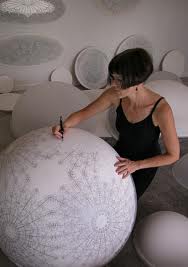As I sat entranced, listening to a wonderful performance of Beethoven's Piano Concerto No. 3 in C minor, I began to think about the parallels between a musician's dexterity of hand and that of a visual artist drawing or painting. Rosa Torres Pardo, the young pianist, was playing with the Baleares Symphony Orchestra. Slender and unaffected, she had an amazing power and delicacy of touch on the keyboard. Her command of the keys was sure and exquisitely balanced, her fingers performing a wonderful ballet up and down the long stretch of keys.
Meanwhile, the Orchestra's violinists, violoncellos, brass and percussionists all demonstrated their skill of hands and arms in similar fashion. Phillippe Bender was conducting and his hands were part of this same fascination I was experiencing as I found the parallels with visual artists.
When you draw in silver or goldpoint, for example, you need to have an exactness, a sensitivity of touch, an understanding of how to move your hand as you make the marks to obtain the desired result. Just like striking a piano key in a certain fashion to obtain the desired sound, or drawing your bow across a violin.
Painting, in oils, acrylics, watercolours – the brush strokes or palette knife's motion all make different effects and renderings on paper or canvas. It is all in the motion of the arm and use of the fingers - the touch, in essence.
Finding unity in our creative endeavours always delights me. Every working artist celebrates the passion that inspires and moves him or her. With our arms, hands and fingers as universal tools in these creations, developing dexterity and command of technical vocabularies is an ever-important part of being an artist. No wonder every musician, ballet dancer, visual artist and conductor practices and practices to improve as an artist.












